P3 5-6/2022 en
Ready for Take-Off
Bio-based Paint Systems for Natural Fibre Reinforced Plastics for Aviation Applications
Research & Innovation
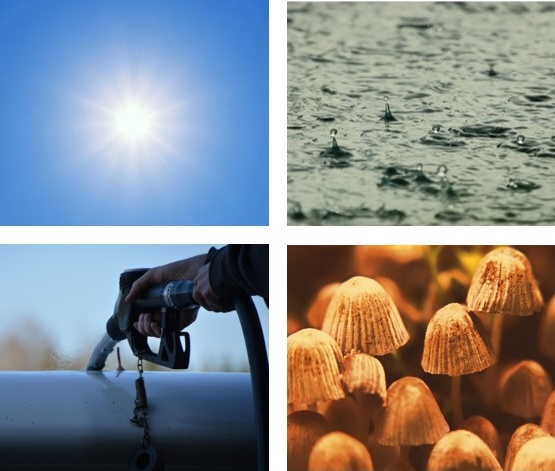
Figure 1: Environmental influences such as UV radiation, moisture, aerospace-specific fluids and microbial growth that aerospace structures must withstand.

This study is part of a joint project aimed at developing a resource-saving lightweight structure made of natural fibre reinforced plastics for aviation. Bio-based materials are used to develop a helicopter cabin door with the highest possible proportion of renewable raw materials. The natural fibre composites used for this purpose are coated with preferably bio-based paint systems to protect them from typical aviation environmental influences. The protective effect of various (bio-based) coatings is therefore investigated in this study with regard to their resistance to UV radiation, moisture and microbial growth, and finally compared with a coating system optimised for aviation applications.
Figure 1: Environmental influences such as UV radiation, moisture, aerospace-specific fluids and microbial growth that aerospace structures must withstand.
Aim/Introduction
This research work is part of the joint project InteReSt-II entitled "Further development of a functionally integrative and resource-saving lightweight structure for aviation", in which a hybrid lightweight structure with the highest possible proportion of renewable raw materials is developed on the basis of a helicopter cabin door. This project is intended to promote the use of bio-based materials in the aviation industry and to show a more sustainable approach for upcoming developments, thus contributing to climate protection. The project is funded by the German Federal Ministry of Economics and Climate Protection (BMWK, Germany, grant number 20E1908C) and the project partners include the IfBB - Institute for Bioplastics and Biocomposites at the University of Applied Sciences and Arts in Hannover, the Institute of Helicopter Technology at the Technical University of Munich (TUM) and the department Lightweight Structures and Polymer Technology at the Chemnitz University of Technology (TUC).
The increasingly drastic effects of climate change make it clear that there is an urgent need to turn away from the unlimited use of fossil raw materials.[1] In particular, the aviation industry still relies heavily on materials of fossil origin, while components based on renewable raw materials are usually sought in vain. This is critical, especially in terms of sustainability, but also in the view of the finite nature of oil reserves. Therefore, it is urgently necessary to develop ecologically friendly material alternatives in comparison to the conventional systems. Accordingly, the aim of this project is to demonstrate that bio-based materials can also meet the high technical requirements of the aviation industry and be sustainable at the same time. Therefore, they must be able to withstand extreme environmental influences during their usage, such as strong ultraviolet radiation (UV), moisture, aviation-specific fluids and microbial infestation, among other things (Figure 1).[2]
The developed lightweight structures are produced with cellulose-based natural fibres and partly bio-based resins and are particularly susceptible to moisture.[3] Therefore, they have to be protected with a coating to maintain the mechanical properties of the components. In the context of this study, coating systems based on renewable raw materials were used for this purpose, even if they were not specifically developed for aerospace or composite materials such as wood preservative coatings based on oxidative drying plant oils (Table 1), because the market currently does not offer any suitable sustainable aerospace alternatives. Coatings from the automotive and aviation industries were used as comparative systems.
The aim of this subproject is to show that the coatings based on renewable raw materials can protect the novel natural fibre-reinforced lightweight structures from the aviation-specific environmental influences and thus enable these sustainable structures to be used in applications with very high requirement profiles such as aviation. The corresponding experiments were carried out at the IfBB.
Materials and Methods
This study presents a natural fibre composite (NFC) based on a flax fibre fabric (Natural fibre1) and a partially bio-based epoxy resin (Resin1). The natural fibre composite samples were prepared via the so-called vacuum assisted resin infusion (VARI) process and cured in an autoclave according to the resin manufacturer's specifications. The coatings used are listed in Table 1 and were applied according to the manufacturer's instructions. Coated and uncoated NFC specimens were exposed to UV radiation in the QUV/spray UV weathering unit from Q-Lab in accordance with the DIN EN ISO 16474-3 standard (cycle 1: 4 h dry UVA 340, 60 °C; 4 h wet condensation, no irradiation, 50 °C) for two (2 W) and four weeks (4 W) and compared with non-weathered specimens (0 W) during analysis. The 4-point bending tests were carried out using a Zwick/Roell Z100 TEW tensile machine following DIN EN ISO 14125. The Spectro-guide 45/0 gloss instrument from BYK-Gardner GmbH was used for the color and gloss measurements, and the surfaces were tested after ageing according to DIN EN ISO/CIE 11664-4 and DIN EN ISO 2813, respectively. Cross-cutting tests (DIN EN ISO 2409) and Buchholz hardness (DIN EN ISO 2815) were performed with a byko-cut universal instrument from BYK-Gardner. To determine the microbial resistance, the samples were brought into contact with the test organisms and incubated for 28 days at 29 °C and 90 % relative humidity in accordance with DIN EN ISO 846:2019.
Results
The aim of the joint project is to investigate whether natural fibre-reinforced composites can withstand aviation-specific environmental influences. The NFC plates were coated with various coating systems to increase resistance applying both bio-based and non bio-based coatings. Figure 2 shows exemplarily four plates with different coatings.
In the following, the investigations regarding the resistance to high-energy UV radiation in humid environments as well as to microbial fouling are presented. To determine UV stability, the samples were stored for four weeks in accordance with DIN EN ISO 16474-3. The cycle used combines irradiation with high-energy UV-A radiation with moist condensation of the sample plates to simulate the conditions in operation. Samples were taken after two- (2 W) and four-week ageing (4 W) and compared with unirradiated samples (0 W). A common method used in the coating industry to obtain an impression of the adhesion of a coating to the substrate is the cross-cutting test. This was carried out in accordance with DIN EN ISO 2409 and the results are listed in Table 2. The cross-cutting rating is done in integer steps of 0-5 CR, where a CR = 0 indicates very good adhesion of the coating to the substrate and a CR = 5 indicates very poor adhesion. The test can be assumed to be passed if values of CR ≤ 1 are achieved. As can be seen from Table 2, coating systems D, E (both automotive) and F (aviation) show a consistently low value of CR = 0-1, indicating good adhesion. Wood preservative coatings A and B also show values of CR = 0 and 1 still being sufficiently low cross-cutting values. Coating type C shows a clear decline in adhesion and longer weathering enhanced this effect.
Changes of the hardness of the coating was determined by means of an indentation test according to Buchholz (based on DIN EN ISO 2815). The indentation length measured is reciprocally proportional to the indentation resistance of the coating, i.e. the greater the indentation length after the test, the less hard is the material. The results of this investigation are shown in Figure 3 and reveal for samples A to D a clear dependence of the indentation length in relation to the aging time: with increasing irradiation time, the indentation length decreases, indicating embrittlement of the coating due to the high-energy UV radiation. For samples E and F, no significant changes could be detected as a function of weathering. This indicates good UV stability of the used coating systems E and F, which were developed specifically for the automotive and aviation industries, respectively.
In addition to their protective properties, the coating systems also make a strong contribution to the visual appearance of the component. Since helicopters are mostly used outdoors, they are increasingly exposed to UV radiation. For this reason, the resistance of the color as well as the gloss before and after weathering with high-energy radiation was also investigated. As shown in Figure 4, fundamental differences between the coating systems become clear. Coatings B, C, and D are high-gloss systems, whereas A, E, and F, as well as the uncoated NFC1, have very low gloss levels and therefore appear dull. In the case of the uncoated system NFC1, there is a significant loss of gloss due to weathering. The reason for this may be the short-wave and high-energy UV radiation, which attacks the surfaces and thus damages them in combination with the moist condensation. Typical decomposition effects that can be caused by the radiation are, for example, chain scission, oxidation and hydrolysis of the macromolecules and pigments.[4] In contrast, for coating systems B and D the gloss level does not change significantly due to weathering, indicating good UV stability. For sample C, the gloss value decreases slightly from GU = 87 (0 W) to GU = 78 (4 W) during the course of weathering, and for sample A, the comparatively low gloss value decreases from 20 GU to 12 GU after four weeks of irradiation. The evaluation of the UV stability of E and F is not possible using this method, since these dull coatings have such low gloss values that a change cannot be detected in an appropriate way.
To obtain more in-depth information, a color analysis was therefore performed. From the brightness values (L*) measured before and after weathering and from the color values a* and b* of the CIELAB color space, the CIELAB color distance ΔE*ab is determined according to DIN EN ISO/CIE 11664-4 as a measure of color differences. Figure 5 shows the color difference of the NFC specimens after two- and four-week UV weathering, in each case with the non-aged zero specimen (0 W) as reference. This means that the greater the value of the color difference ΔE*ab, the more the color of the weathered sample differs from that of the non-exposed sample caused by a stronger damage of the coating material by the UV radiation. Therefore, the very high ΔE*ab values of the uncoated NFC1 sample show that the surface of the natural fibre composite is strongly affected without a protective coating. Small color differences with ΔE*ab values between 2 and 5 can be observed for the wood preservative coatings A, B and C. Unexpectedly for an aviation coating system, sample F also shows minor but still measurable color changes. Coating systems D and E stand out in this test, as almost no color changes can be detected. These coatings were specially developed for the automotive industry. This can explain the positive performance in the test, as this industry places a correspondingly high value on color fastness and therefore, the coating systems are equipped with potent UV protection additives.[5] Overall, this weathering test clearly shows that a coating of the natural fibre composite components is essential to protect them from aggressive UV radiation. Furthermore, it must be emphasised that with sample E one of the best performing systems in this weathering test was partly produced from renewable raw materials.
To gain an impression of the influence of UV weathering on the mechanical properties, bending tests were carried out on the aged specimens in accordance with DIN EN ISO 14125. Only for the uncoated NFC1, a slight decrease in the Young's modulus was observed. In the case of the coated specimens, no significant change in Young's modulus was evident (data not shown). This again highlights the need to coat the natural fibre composites to reduce the stress of exposure to UV radiation and moisture to counteract mechanical failure.
Due to their location of use, aircrafts must be able to withstand not only sunlight and rain, but also the animate nature. The cellulose-based natural fibres, which are used to manufacture the composites developed in this project, can serve as a food source for various fungal cultures.[6] Therefore, the microbial resistance, i.e. the resistance to fungal growth of the uncoated and coated samples was investigated. In accordance with DIN EN ISO 846, the samples were brought into contact with test organisms and incubated for four weeks under optimum growth conditions. Since no further carbon source is added, growth of the fungi indicates that the samples can be used as a source of nutrients and thus resistance to microbial growth is not given. Fungal cultures that attack both natural fibres and plastics were specifically selected to determine effects on the used coating systems. The evaluation takes place visually on the basis of the fungal growth on the sample surface and is classified from 0 (no growth) to 5 (strong growth), where it can be assumed that a growth intensity of ≥ 2 does not imply resistance to the test organisms.
To obtain an overall impression of the materials used, the flax fibres without resin (natural fibre1) and the epoxy-resin used (Resin1) were examined in their pure form in addition to the uncoated natural fibre composite (NFC1). Furthermore, the protective effect of the coatings A, B, C and D on the NFC1 substrate was analysed (Table 3).
Despite the high cellulose content, the natural fibre1 unexpectedly did not show any increased microbial growth compared to the negative sample, although fungal cultures were used which specifically attack cellulose. This could be explained by a too short test duration or a special fibre sizing that prevents fungal growth. In contrast, slightly increased fungal growth was observed applying the resin-only system and NFC1, which is why these samples are classified as not resistant to the fungal strains investigated. The increased growth on the fossil-based automotive system D is unexpected, as approved automotive coatings were assumed to have a high resistance to microbial fouling. The bio-based oxidative drying system A also showed deficiencies in resistance to the fungi tested. In contrast, the other wood preservative coatings B and C, which are also bio-based and oxidatively drying, do not serve as a nutrient source for the microorganisms used and are therefore resistant. These tests have shown partly unexpected results. The components come into contact with a wide range of microorganisms during their use phase, which highlights the need for such tests in the development of structures and their coatings. Therefore, other potential partially bio-based coatings will be tested for their resistance to microbial resistance during the course of the project.
Conclusion
This study investigated whether natural fibre composites can be protected by environmentally friendly coatings against aviation-specific environmental influences. For this purpose, the effects of various partially bio-based coating systems were compared with that of fossil-based standard automotive and aviation systems. It was found that coating the natural fibre composites is essential to enable the NFCs to withstand the environmental conditions during their use. Furthermore, the results shown in this report have demonstrated that the combination of natural fibre composites and bio-based coating systems tend to be suitable for the use in aviation environments. Further investigations, e.g. on resistance to aviation-specific fluids, as well as analyses of other (bio-)based coatings are in progress. Resistance to moisture and various temperatures will be investigated by project partners as part of the joint project. Finally, a demonstrator component (helicopter cabin door) will be manufactured with the highest possible proportion of renewable raw materials and coated with the paint system that has shown the best results in the ongoing tests. The project will be accompanied by a life cycle assessment (LCA) of the door production process and the (bio)-based materials required. By combining the development of the coated door with the durability tests and the LCA, the aim is to show that sustainable materials can also be used in highly demanding areas of application such as aviation and have an ecological advantage over conventional fossil-based materials.
Authors
Dr. Hannes Schäfer (Research Associate), Beatrice Lühring (Research Assistant), Marco Neudecker (Research Associate), Dr. Stephen Kroll (Senior Engineer), Prof. Dr.-Ing. Andrea Siebert-Raths (Head of IfBB)
IfBB – Institute for Bioplastics and Biocomposites, Hannover University of Applied Sciences and Arts, Heisterbergallee 10A, 30453 Hannover, Germany
References
- Union of concerned scientists, The Hidden Costs of Fossil Fuels, https://www.ucsusa.org/resources/hidden-costs-fossil-fuels, 10.08.2022.
- S. Abbas et al., A Review on SHM Techniques and Current Challenges for Characteristic Investigation of Damage in Composite Material Components of Aviation Industry, 2018, Materials Performance and Characterization, Volume 7, Page 224-258.
- A. Moudood et al., Flax fiber and its composites: An overview of water and moisture absorption impact on their performance, 2019, Journal of Reinforced Plastics and Composites, Volume 38, Page 323-339.
- D. Feldman, Polymer Weathering: Photo-Oxidation, 2002, Journal of Polymers and the Environment, Volume 10, Page 163-173.
- Deutsches Lackinstitut, Nanotechnologie in der Autoserienlackierung, https://www.lacke-und-farben.de/magazin/wissenschaft-technik/nanotechnologie-in-der-autoserienlackierung, 10.08.2022.
- B. Crawford et al., Effect of Fungal Deterioration on Physical and Mechanical Properties of Hemp and Flax Natural Fiber Composites, 2017, Materials, Volume 10, Page 1252-1265.
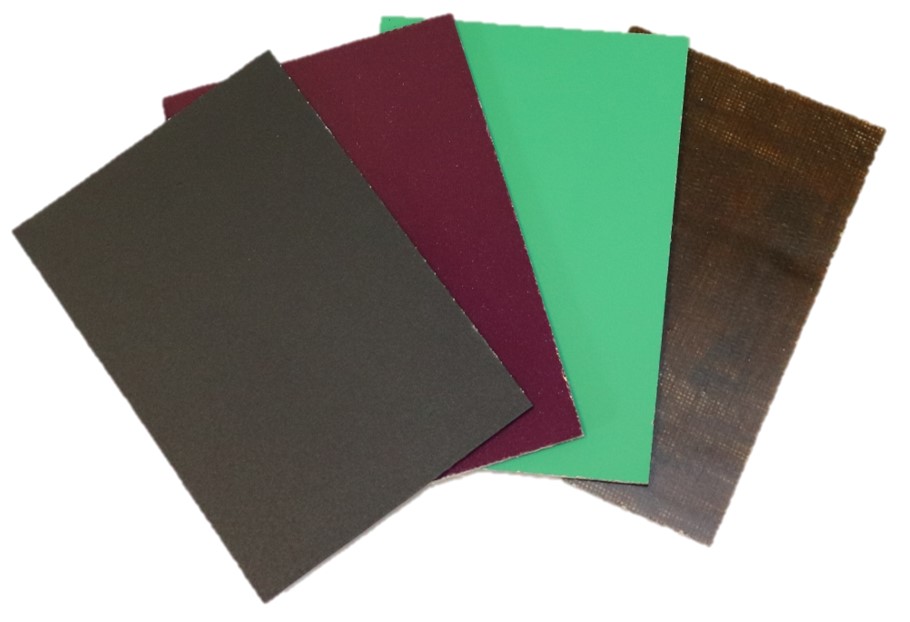
Figure 2: Pictures of natural fibre composite samples (11 mm x 7.5 mm x 2 mm), from left to right: NFC with coating E, D, F and without coating.

Table 2: Cross-cutting rating (CR) of the coated natural fibre composites A - F before (0 W), after two-week (2 W) and four-week (4 W) weathering.
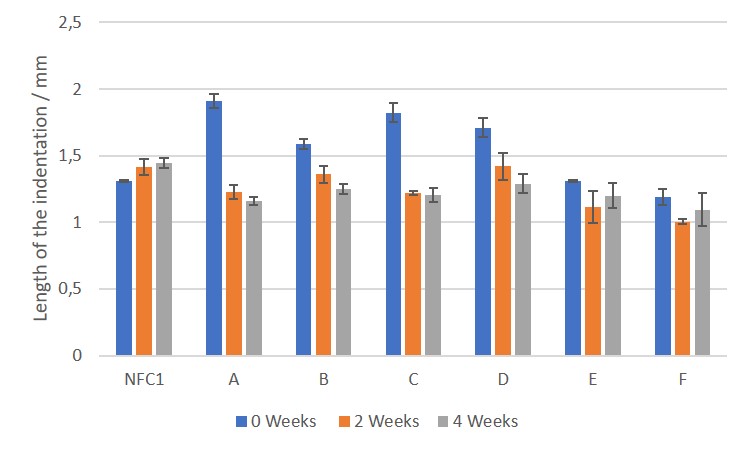
Figure 3: Length of indentation in mm of tested natural fibre composites without (NFC1) and with coating (A, B, C, D, E, F) before and after two and four weeks of weathering.
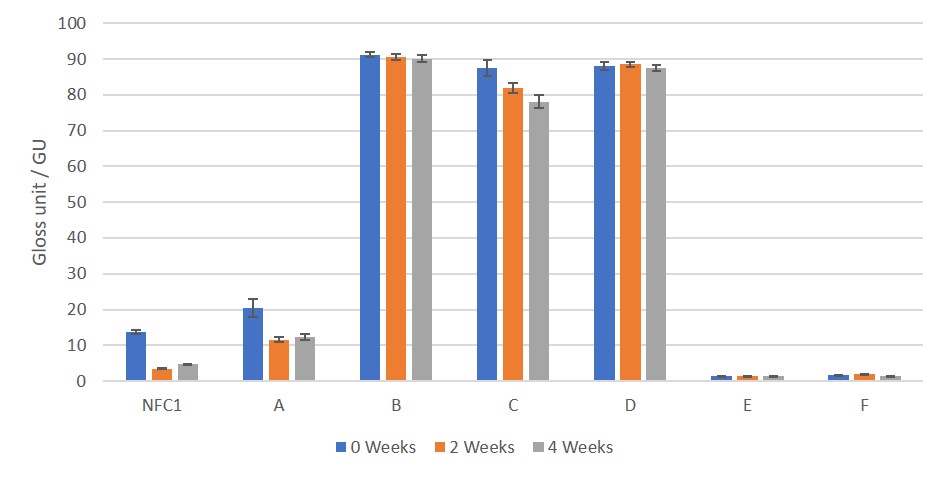
Figure 4: Results of gloss measurements of NFC without and with coating, unweathered (0 weeks) and after two- and four-weeks of weathering.
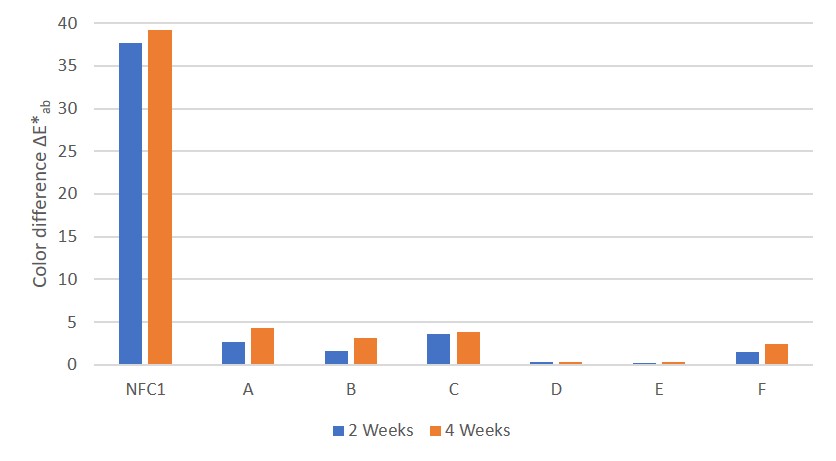
Figure 5: Color difference ΔE*ab of the natural fibre composites with and without coating after two and four weeks in relation to the non-weathered aged sample.
Authors: Dr. Hannes Schäfer, Beatrice Lühring, Marco Neudecker, Dr. Stephen Kroll, Prof. Dr.-Ing. Andrea Siebert-Raths
Editor: sbr
Images: Pixabay [1]; IfBB [2-5]








